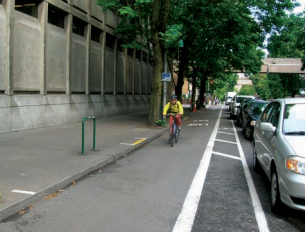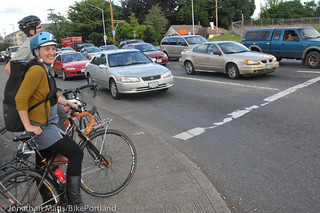
State University, from page 1-30 of ODOT’s
Bicycle and Pedestrian Design Guide.
On Monday, we highlighted a few bike ideas from around the country that Oregon might imitate, but so far hasn’t. One of them: formally endorsing the National Association of City Transportation Officials design guides.
But Jessica Horning, the transit and active transportation liaison for the Oregon Department of Transportation’s Region 1 (which contains the Portland metro area) replied to our question about this with a fair argument: Oregon’s in-house design guide is already really good.
Developed by practitioners in Portland and other cities around the country, the NACTO guides are a sort of professional Pinterest for human-friendly street designs such as protected bike lanes and traffic diverters. Images are well-annotated and informed by extensive research about safety and performance.
Washington, Massachusetts and California have all endorsed NACTO’s guides. It’s a big development for California in particular, where state regulators have until recently tried to prevent the construction of physically separated bikeways.
But here’s what Horning says about the situation here:
ODOT’s Pedestrian and Bicycle Design Guide was developed and adopted in 2011 – about the same time the NACTO Urban Bike Design Guide was being developed and published – and contains design guidance on many of the same design treatments that are covered in the NACTO guide. ODOT has formalized the guidance for the newer facility types in the NACTO and ODOT design guides (e.g. cycle tracks, raised bike lanes) into standards in our Highway Design Manual (Chapter 13). The ODOT guide also covers many rural/suburban design issues (e.g. rumble strips, chip sealing) that are not addressed by NACTO, but are vital for ODOT to keep in mind to facilitate pedestrian and bicycle access and safety in the non-urban areas we serve.
Here in Region 1, there are copies of the NACTO Urban Bikeway and Urban Street Design Guides available at my desk that staff regularly borrow for reference. We have hosted brown bag lunch presentations on the guides (in addition to our regular monthly Association of Pedestrian and Bicycle Professionals webinar series) to make sure staff are familiar with the subject matter and many of our staff have attended trainings that cover the NACTO guides. They are definitely valuable resources, and I can see the potential value in endorsing them. From a personal/practitioner viewpoint, however, I would prefer to identify any important guidance that is in lacking from our existing ODOT manuals and work to make revisions, rather than adding another two books onto our huge existing stack of advisory documents. It seems like things are a lot more likely to be implemented if they’re all in one place alongside all the other standards.
In a way, NACTO’s design guides are the standardized tests of the bike/pedestrian planning world, but maybe Oregon is already among the gifted and talented. It’d be interesting to hear other perspectives on this.

